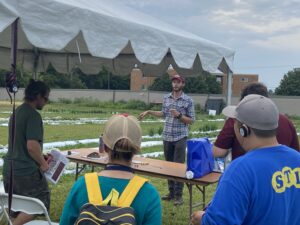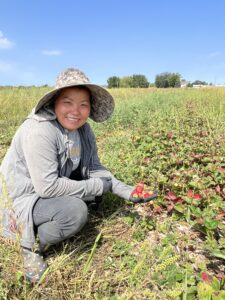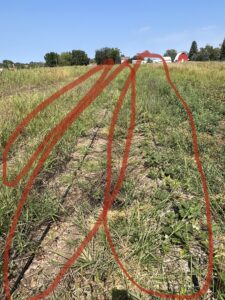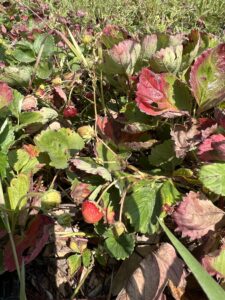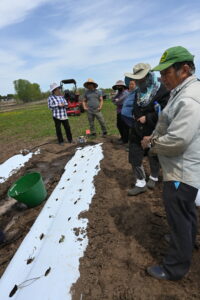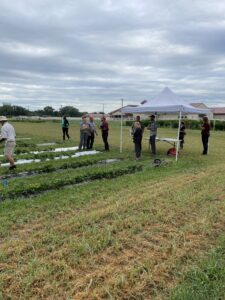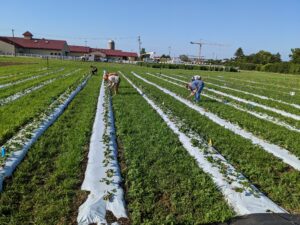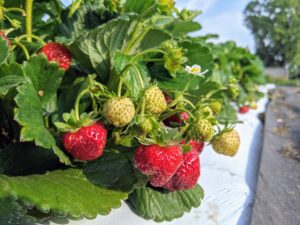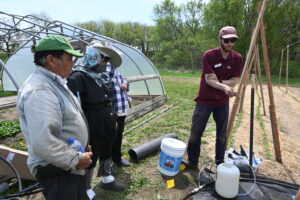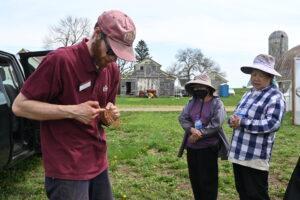Progress report for LNC21-457
Project Information
The title of our proposal is Advancing Sustainable Management Techniques for Spotted-Wing Drosophila in Strawberries in Minnesota. Spotted-wing drosophila (Drosophila suzukii, SWD) is an invasive fly that lays eggs in small fruit as it ripens. Management of SWD is largely based on repeat applications of broad-spectrum insecticides, which may have deleterious ecological impacts on non-target species, soil, and water quality, and contribute to insecticide resistance. Currently there is little understanding of the management or economic impact of SWD on day-neutral (DN) strawberries, a horticultural crop with high statewide economic value. Although there has been an increase in research on SWD management, little research has focused on strawberry specifically, despite high consumer demand for this and other fruits. Therefore, the objectives of this research and outreach project are: 1) test cultural and behavioral-based management strategies for SWD control and cost effectiveness; 2) facilitate strawberry demonstrations and learning opportunities for growers alongside the Hmong American Farmers Association (HAFA); 3) develop case studies with individual farmers to share information about strawberry production, pest control and profitability. SWD management strategies will include techniques that have previously shown promise in our research on raspberries but have not been tested in strawberries and need additional field validation. These include increasing harvest and field sanitation, use of botanical-based repellents, and a weekly rotation of OMRI microbial-based pesticides. We anticipate that efficacy across treatments will vary, as will labor and input costs; therefore we will also apply a cost-benefit analysis to our work. This proposal has been developed in partnership with HAFA, who have growers interested in trialing DN strawberries. This also allows us to leverage a pre-existing grant HAFA recently received to initiate a new grower training program with DN strawberries. This research project will enhance the impact of this work as well as complement the training by including a focus on integrated pest management. Overall, this project will provide data-validated management recommendations for farmers with the aim of reducing broad-spectrum insecticide use and improving profitability for the small fruit industry in Minnesota.
Learning outcomes include an increased understanding of the efficacy of cultural control practices to reduce SWD infestation and damage and to explore the economic feasibility of various management strategies for DN strawberries. This knowledge will allow us to make recommendations to growers with the overall goal of reducing insecticide applications and improving profitability. Through our engagement with HAFA, new growers will learn about best management practices including integrated pest management for DN strawberries. Overall, our goal is to increase sustainable local production and season-wide availability of strawberries and increase farm revenue for this high-value crop.
Demand for locally produced strawberries is high in Minnesota, and the north central region as a whole. This offers an opportunity for local farmers to grow more berries to meet consumer demand. However, fruit production is challenging for emerging farmers due to the fact that most fruit crops take multiple years to establish, which results in delayed returns on investment. Additionally, new farmers typically rent rather than own land, which creates barriers to entry for perennial crops. There is increasing interest in annual day-neutral (DN) strawberry production, however this is still underdeveloped in the Upper Midwest. In Minnesota, DN varieties are grown annually, producing fruit continuously from July until frost in the fall. Therefore, DN production may be more suitable than our typical June-bearing strawberry production systems for emerging farmers with less permanent access to land. Despite interest in DN production, adoption is lagging. A recent survey was distributed to conventional fruit and vegetable growers through multiple channels including list servers from University Extension, grower associations, and CSAs. Results from the survey indicated a significant interest in growing DN strawberries with 67% of the respondents indicating the need for more research-based information on how to grow DN strawberries and identified spotted-wing drosophila (SWD) as a key management concern. Therefore, this proposal focuses specifically on effective and economically feasible pest management practices for SWD in DN strawberry systems relevant to growers in our region.
Cooperators
Research
Hypothesis: the research on cultural and behavioral-based management strategies for SWD control will reveal a an organic pest-management practice that is cost effective for day-neutral strawberry production and can be adopted by growers.
We propose three research and outreach activities for this project: 1) test cultural and behavioral-based management strategies for SWD control and cost effectiveness; 2) facilitate strawberry demonstrations and learning opportunities for growers; and 3) develop case studies with individual farmers about strawberry production, pest control and profitability. These activities relate to the three priority themes of sustainable pest management, marketing and local food systems, and human dimensions of priority invasive-species issues. The methods and approach are listed for each activity below.
Activity 1: Test SWD control strategies and profitability in strawberries
We will conduct rigorous field trial and on-farm experiments to help growers determine the most economically effective SWD control practices for strawberry production and the financial feasibility of growing organic day-neutral strawberries in the Upper Midwest.
A preliminary survey administered by key personnel DiGiacomo shows that farmers primarily use insecticidal sprays for managing SWD but are also interested in non-pesticidal and organic methods if they are economically effective. Our previous preliminary research on raspberries shows promising results for cultural controls including increasing harvest frequency and botanical-based repellents, but these techniques have not been validated or studied in DN strawberries. Therefore, our cultural control treatments will include: 1) sanitation through harvesting all ripe fruit three times per week and removal of unmarketable and fallen fruit from plants; 2) botanical-based deterrent (Ecotrol Plus) sprayed weekly; 3) a rotation of spinosad (Entrust) and Grandevo (OMRI approved pesticides) as a positive control check; and 4) an untreated control with strawberries harvested twice weekly. We will have four replications (100 ft long rows) arranged in a randomized block design for a total of sixteen plots (50 plants per plot) located at the University of Minnesota, St. Paul campus MN Agricultural Experiment Station. Planting will occur in the spring when soils have thawed and drained sufficiently for tractor activity. Cultural practices will be implemented by initially rotovating the soil, followed by raised bed preparation with a bed shaper, and plastic mulch and drip tape application with a mulch layer. After mulch application, bare-root ‘Cabrillo’ strawberries will be planted in mulch in holes punctured with a dibble bulb and seed planter. This cultivar was selected based on the high yields and fruit quality results from previous cultivar evaluation studies performed by UMN. Alleyway between strips will be planted with annual rye every year after raised bed preparation.
Plots will be fertigated using drip tape applicators underneath each mulch type, at the rate of 6.1 kg ha-1 of fertility solution per week. As a fertility source, an organically approved fertilizer, AgGrand Organic Series fertilizer, 4N-1.3P-2.5K will be used. Tensiometers will be installed in one strip of each color mulch treatment at depths of 30 and 45 cm to schedule irrigation. All plots will be irrigated when tensiometers average -30 kpa. Inflorescences will be removed until the last week of June to ensure vegetative growth and root establishment immediately after planting. Plots will be harvested twice each week, but only once each week for the first and last harvest weeks of each season, when yields are lower. During each harvest, all berries picked within a selection zone, consisting of the interior 28 plants within each split plot replicate, will be weighed for experimental unit yield as described by Petran (2017). For the control plots, yield from each of the two harvests per week will be combined to calculate weekly yield per plot, and three harvests a week will be combined for the frequent harvest treatment. Twenty berries in each selection zone will be randomly selected, weighed, and divided by 20 to gauge average berry weight for that plot. The percent of marketable fruit will be evaluated throughout the season at one harvest per week as described by Anderson et al. (2019). USDA standards will be used to group fruit into U.S. No. 1 or U.S. No. 2, based on size and uniformity, and all else (designated as low grade or unmarketable in this study). For the purposes of this experiment, USDA grade U.S. No. 1 and U.S. No. 2 together constitute the “marketable quality” fruit category. Spray treatments will be applied once per week at the maximum label rate using a single boom CO2 pressurized backpack sprayer (Bellspray, Inc, Opelousas, LA) and applied 24 hours prior to harvesting.
We will measure the amount of fruit infested by SWD by randomly selecting 10 fruit per plot per harvest to visually assess under a dissecting microscope for the number of SWD eggs. Fruit can be characterized by percentage of infested berries (positive or negative for any eggs). Samples will be analyzed using a GLMM ANOVA on proportion of infested fruit per plot. The model will incorporate fixed effects of treatment, including block number as random factors. Treatment means will be compared using a Dunnet’s post-hoc test.
After the field seasons have concluded, we will study the economic impact of SWD cultural control strategies first by developing an enterprise budget for organic day-neutral strawberries. Enterprise budgets list income, expenses and estimated profitability for one season. The enterprise budget will serve as an economic baseline for organic day-neutral strawberry production in the Upper Midwest where standard harvest practices (2X/week) and routine organic insecticide rotations (Entrust + Grandevo) are assumed.
Marketable yield data needed for the enterprise budget will be collected from the research station and HAFA demonstration plots. Economic data collection techniques and methods will be documented and provided to field researchers in advance of planting. Throughout the strawberry season, data for the research station plots will be compiled by field researchers and recorded in an Excel spreadsheet. Marketable yield data will be collected from HAFA growers using an interview format three times throughout the season (early harvest, mid-season harvest, late season harvest). Translators will be on hand at HAFA to assist with data collection.
Seasonal, weighted average retail prices for strawberries, available bi-weekly for conventional and organic strawberries from USDA Agricultural Market News Service, will be applied to marketable yields to calculate gross returns. Material inputs used for the four treatments will be recorded by researchers at the experiment station and valued using market rates. Labor required for planting, mulch and irrigation, maintenance/pruning, repellent and insecticide applications, and harvest and packing will be compiled primarily by researchers at the experiment station. We will test the labor efficiency of research staff by observing the time required by HAFA growers to prune/maintain plants and to harvest berries. We suspect that HAFA growers will be more efficient than researchers when harvesting due to grower experience. Fixed and variable costs (input materials and labor) will be deducted from gross returns to arrive at net profitability.
A partial budget analysis will be applied to explore how net returns and overall profitability change when cultural controls (sanitation and organic repellents) are used in place of the standard organic practices (2X/week harvest and Entrust + Grandevo insecticide rotation). The partial budget method accounts for changes in marketable harvest, labor, and input costs. Fixed costs remain unchanged. We will test the rigor of results by applying a sensitivity analysis where price, yield and harvest rates are varied to account for differences in sales channels, SWD infestation, and grower experience, respectively. A rigorous study on enterprise profitability will further our understanding of SWD’s economic impact on strawberry production and the economic viability of day-neutral strawberry production in the Upper Midwest.
Activity 2: Facilitate strawberry demonstrations and learning opportunities for growers
We will engage new audiences and provide research-based support to historically underserved grower communities around managing day-neutral strawberries. We will partner with HAFA for on-farm research and demonstration during the first two years of this project. This will occur via three different modes: 1) demonstration plots at HAFA; 2) training presentations and IPM workshop; and 3) farmer trials.
A demonstration plot (1/3 acre) will be established at the HAFA farm containing four different DN varieties (Seascape, Albion, Cabrillo, San Andreas). This will provide an opportunity for emerging farmers to observe how the varieties perform and differences in yield, quality, and pest pressure. The UMN GRA (Gullickson) and undergraduate research assistant will help establish the plantings and visit the demonstration plot to collect yield data and monitor for SWD in fresh fruit via salt extraction tests twice per month during the growing season. As part of a pre-existing program, HAFA is providing training sessions on best management practices for growing DN strawberries with Annie Klodd (UMN Extension Educator) in January 2021 & 2022. The graduate research assistant (Matthew Gullickson) will co-present on integrated pest management alongside Extension Educator Annie Klodd during the January 2022 session. The training presentation will be adapted to be interactive and visually descriptive for efficient and effective training for Hmong farmers. Furthermore, each training will be conducted in conjunction with a HAFA staff to translate training materials. Each summer during the growing season, Gullickson and Rogers will host an IPM workshop on strawberry pests onsite at HAFA, using the demonstration plot, with translation services provided by HAFA staff. Additionally, individual growers (up to 6 per year) will be invited to grow small plots of DN strawberries on their own sites to record their experiences with these cultivars and practices. In addition to the training sessions provided above, HAFA will provide one-to-one follow up sessions on their farm plots, evaluations with our Farm Manager and Farm Advocate, with opportunities to reach out with follow questions and concerns. Each participating farmer will receive strawberry starters. University researchers will host planning meetings with HAFA staff in March prior to the growing season and in November at the end of the season to better understand practices that work for growers, help estimate production costs and profitability, help answer questions, and listen to grower feedback to ensure that knowledge is exchanged both ways. Farmers will be reached through electronic, print, and word of mouth communications. HAFA will contact all 140 farmers on their farmer-member list and use Hmong community connections, Hmong radio programs, and Hmong social media accounts and groups. These recruitment methods have potential to reach over 600 Hmong farmers in the Twin Cities metropolitan and Southwestern Minnesota areas.
Activity 3: Develop case studies with individual farmers about strawberry production, pest control and profitability
We will create Extension-ready grower case studies by interviewing the HAFA farmer collaborators and other Minnesota farmers using non-chemical techniques on SWD management strategies and day-neutral production practices, featuring multi-language producer profiles and field trial results.
Feedback provided by 315 MN fruit and vegetable growers in a 2018-2019 survey conducted by UMN Extension (Klodd and Hoidal 2019) suggests that growers prefer learning from other growers. We will create three Extension-ready grower case studies that highlight effective, profitable control strategies for SWD and the production of DN strawberries in the Upper Midwest. The case studies will combine field trial research data with new grower interviews, photographs and infographics using a new template developed by a graphic artist for this project. The case study template will be designed so that it can be re-used by Extension for future case studies on invasive pest management, alternative crops and innovative management practices. Each case study will answer basic questions such as “Does it pay to spray for SWD?” Each case study will be 2-4 pages and made available electronically for easy download in English and Hmong. Each case study will include a grower interview and supporting research results. Photos taken on site at the research site and HAFA grower plots will be included.
The primary audience for the case studies are Upper Midwest fruit and vegetable growers representing 608,438 acres (2017 Census of Agriculture) and the Extension educators who serve them. We also anticipate widespread use of the case studies by many of the nation’s 33,919 fruit growers and 2,900 Extension offices.
The invasive spotted-wing drosophila (Drosophila suzukii; SWD) threatens small-fruit and berry
production, particularly in organic systems. At the same time, day-neutral strawberry (DNS)
production is increasing in the Upper Midwest due to its extended harvest season and greater
yield over June-bearing varieties. However, the longer season increases fruit exposure to SWD.
Pest management can increase the costs of production, and organic DNS growers lack
information on the cost effectiveness of management tactics for SWD. To address this
knowledge gap, we established a two-year controlled field experiment with organic DNS. We
applied treatments corresponding with techniques that local growers report using or that have
shown promise in organic raspberries: increased harvest frequency, botanical-based repellents,
and weekly rotations of organic insecticides, which we compared to an untreated control. We
hypothesized that non-insecticidal management strategies would be as effective and cost less
than organic insecticide applications. We collected data on labor hours, direct costs, strawberry
yield, and SWD infestation across the 2022 and 2023 seasons. On average, 33% of strawberries
contained SWD eggs. Unfortunately, the tested treatments showed inconsistent effectiveness in
reducing infestation compared to the control. Both insecticide and botanical spray treatments
yielded negative returns over the study period. Frequent harvest and control treatments nearly
broke even. Thus, alternatives like exclusion netting or post-harvest cold treatments, which
reduce egg viability without harming non-target insects, may offer more cost-effective solutions
than organic sprays for managing SWD in organic DNS.
Education
The educational approaches of this project included hands-on learning as well as informational presentations. These included virtual and in-person workshops with growers, grower trials with day-neutral strawberries, on-farm demonstrations, a grower field day, published case studies, oral presentations at grower conferences, and undergraduate research projects.
Project Activities
Educational & Outreach Activities
Participation Summary:
- Workshops, grower trials, and demonstration at HAFA. Two day-neutral (DN) strawberry production workshops were held with the Hmong American Farmers Association (HAFA). The first was an in-person training held in Feb. 2023, and the second was a hands-on planting demonstration held in May, 2023. Six farmers that have plots at the HAFA farm and participated in trials growing DN strawberries in 2023. In addition to farmer trials, a demonstration plot was established and maintained at the HAFA farm for observations, led by Nichole Wamma and Dao Yang.
- Two case studies have been developed and are now published online. The case studies are based on grower experiences with DN strawberries, the first one is titled "Growing Day Neutral Table Top Strawberries at Double T Acres Farm" and features Todd and Tracy Linbo in Nisswa, MN. Printed copies of this case study were disseminated at the MDA Organic Conference and MN Fruit & Vegetable Conference in 2023. The second case study is titled: "Strawberries: Season Extension" and features Aaron Wills from Little Hill Berry Farm in Northfield, MN.
- A poster presentation on research results titled: "Assessing spotted-wing drosophila organic control methods and economic viability in day-neutral strawberry production" was given at the Marbleseed Organic Growers conference in Feb., 2o24 (Rogers and DiGiacomo).
- Our DN strawberry research plots on the UMN St. Paul campus were featured at the Organic Fruit & Vegetable Field Day on the St. Paul campus on July 25th, 2023, and attended by 75 people.
- The research plots on the St. Paul campus provided an opportunity for an undergraduate research project, Will Pradel (UMN, Sustainable Agriculture and Food Systems) completed a research project titled "Host suitability of day-neutral and June-bearing strawberry cultivars for spotted-wing drosophila" in 2023.
In progress: short videos on DN strawberry production will be created and available in both English and Hmong in 2024, and published online on the UMN Extension DN strawberry webpage.
Matt Gullickson is invited to present research findings at the North Central Branch meeting of the Entomological Society of America in March, 2024
We have a draft paper for submission to the Journal of Economic Entomology in prepartion
Learning Outcomes
- day neutral strawberry horticultural production basics (fertility, irrigation, weed management via mulching, low tunnels, post-harvest handling)
- day neutral strawberry pest ID and pest management
- production costs and market value for day neutral strawberries
Project Outcomes
Growing organic day neutral strawberries
At our 2023 Organic Fruit & Vegetable field day on the St. Paul campus:
“I appreciate connecting with people that do the research and work on food production professionally. Finding out how the experts do things is terrific. Also, being on site and seeing things growing in fields [is] very helpful.” -2023 attendee
From Dao Yang, Hmong American Farmers Association:
"We are always interested in building our farmers capacity and continuing to learn more so we can better support farmers. I think that our farmers have a good understanding on traditionally grown strawberry in the field and high tunnels, and have started to shift interest in table top production which was introduced this spring to some of the farmers:
Information Products
- Strawberries: Season Extension (Decision-making Tool)
- Strawberries: Season Extension with Caterpillar Tunnels (Decision-making Tool)
